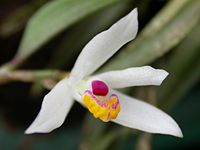Loefgrenianthus: Difference between revisions
imported>Dalton Holland Baptista No edit summary |
imported>Dalton Holland Baptista No edit summary |
||
| Line 21: | Line 21: | ||
*''Loefgrenianthus blanche-amesiae''<small> (Loefgr.) [[Hoehne]] 1927</small> | *''Loefgrenianthus blanche-amesiae''<small> (Loefgr.) [[Hoehne]] 1927</small> | ||
| subdivision2_ranks = Synonyms | | subdivision2_ranks = Synonyms | ||
| subdivision2 = None | | subdivision2 = | ||
*None | |||
}} | }} | ||
'''''Loefgrenianthus''''' is an [[orchid]] genus formed by only one very rare small [[epiphytic]] species, ''Loefgrenianthus blanche-amesiae'', inhabitant of [[Serra do Mar]] mountains in [[Brazil]]ian southeast. It can be differentiated from its closest genus, ''[[Leptotes]]'', both because of its pending vegetation with flat [[leaf|leaves]] and the [[flower]]s which have a saccate [[labellum]]. | |||
==Distribution and habit== | |||
''Loefgrenianthus blanche-amesiae'' is a small epiphytic species which inhabits the highest areas of [[Atlantic Forest]] of [[Rio de Janeiro State|Rio de Janeiro]], [[São Paulo State|São Paulo]] and [[Paraná]] States of Brazil,<ref name="OB"><span style="font-variant:small-caps">Pabst, Guido & Dungs, Fritz </span>: '''Orchidaceae Brasilienses vol. 1''' p. 148. Brucke-Verlag Kurt Schmersow, Hildesheim, 1975. ISBN 3871050106 </ref> particularly in [[Serra da Mantiqueira]] and [[Serra do Mar]] chains of mountains, where it is very rare. It grows under the shadow of [[tree]]s in shady, humid and well ventilated woods, between 1,000 and 2,200 meters of [[altitude]] on mountains slopes. It ordinarily grows at middle height, pending from thick [[stem]]s, mostly of ''[[Podocarpus]]'' and ''[[Araucaria]]'' species,<ref name="CBGO"><span style="font-variant:small-caps;">Van den Berg, Cássio</span>: ''Loefgrenianthus'' in '''Genera Orchidacearum Vol.4''', pp. 274-275. Oxford University Press, 2006. ISBN 9780198507123.</ref> despite there are records of plants occasionally growing in thin [[branch]]es too.<ref name="DM"><span style="font-variant:small-caps;">Miller, David; Richard Warren; Izabel Moura Miller & Helmut Seehawer</span>: '''Serra dos Órgãos sua história e suas orquídeas''', p. 241-242. Rio de Janeiro, 2006.</ref> | |||
==Description== | |||
{| class="wikitable" align="right" style="float:right;" border="2" cellpadding="4" cellspacing="0" style="margin: 0 0 0.5em 1em; background: #f9f9f9; border: 1px #aaa solid; border-collapse: collapse; font-size: 80%;" | |||
|- align="center" | |||
|colspan="3"|'''Measures''' (mm) | |||
|- | |||
| '''Structure''' | |||
| '''Lenght''' | |||
| '''Wide''' | |||
|- | |||
| Rhizome | |||
| 10 | |||
| 1 | |||
|- | |||
| Leaf | |||
| 30 | |||
| 5 | |||
|- | |||
| Pseudobulb | |||
| 2 | |||
| 1 | |||
|- | |||
| Inflorescence | |||
| 10 | |||
| 1 | |||
|- | |||
| Flower | |||
| 20 | |||
| 20 | |||
|- | |||
| Sepal | |||
| 8 | |||
| 3 | |||
|- | |||
| Petal | |||
| 7 | |||
| 3 | |||
|- | |||
| Labellum | |||
| 7 | |||
| 3 | |||
|} | |||
==References== | |||
{{reflist|2}} | |||
Revision as of 15:47, 15 March 2009
| Loefgrenianthus | ||||||||||||||||||||
|---|---|---|---|---|---|---|---|---|---|---|---|---|---|---|---|---|---|---|---|---|
 | ||||||||||||||||||||
| Scientific classification | ||||||||||||||||||||
| ||||||||||||||||||||
| Type species | ||||||||||||||||||||
| Leptotes blanche-amesiae Loefgr. 1918 | ||||||||||||||||||||
| Species | ||||||||||||||||||||
| ||||||||||||||||||||
| Synonyms | ||||||||||||||||||||
|
Loefgrenianthus is an orchid genus formed by only one very rare small epiphytic species, Loefgrenianthus blanche-amesiae, inhabitant of Serra do Mar mountains in Brazilian southeast. It can be differentiated from its closest genus, Leptotes, both because of its pending vegetation with flat leaves and the flowers which have a saccate labellum.
Distribution and habit
Loefgrenianthus blanche-amesiae is a small epiphytic species which inhabits the highest areas of Atlantic Forest of Rio de Janeiro, São Paulo and Paraná States of Brazil,[1] particularly in Serra da Mantiqueira and Serra do Mar chains of mountains, where it is very rare. It grows under the shadow of trees in shady, humid and well ventilated woods, between 1,000 and 2,200 meters of altitude on mountains slopes. It ordinarily grows at middle height, pending from thick stems, mostly of Podocarpus and Araucaria species,[2] despite there are records of plants occasionally growing in thin branches too.[3]
Description
| Measures (mm) | ||
| Structure | Lenght | Wide |
| Rhizome | 10 | 1 |
| Leaf | 30 | 5 |
| Pseudobulb | 2 | 1 |
| Inflorescence | 10 | 1 |
| Flower | 20 | 20 |
| Sepal | 8 | 3 |
| Petal | 7 | 3 |
| Labellum | 7 | 3 |
References
- ↑ Pabst, Guido & Dungs, Fritz : Orchidaceae Brasilienses vol. 1 p. 148. Brucke-Verlag Kurt Schmersow, Hildesheim, 1975. ISBN 3871050106
- ↑ Van den Berg, Cássio: Loefgrenianthus in Genera Orchidacearum Vol.4, pp. 274-275. Oxford University Press, 2006. ISBN 9780198507123.
- ↑ Miller, David; Richard Warren; Izabel Moura Miller & Helmut Seehawer: Serra dos Órgãos sua história e suas orquídeas, p. 241-242. Rio de Janeiro, 2006.